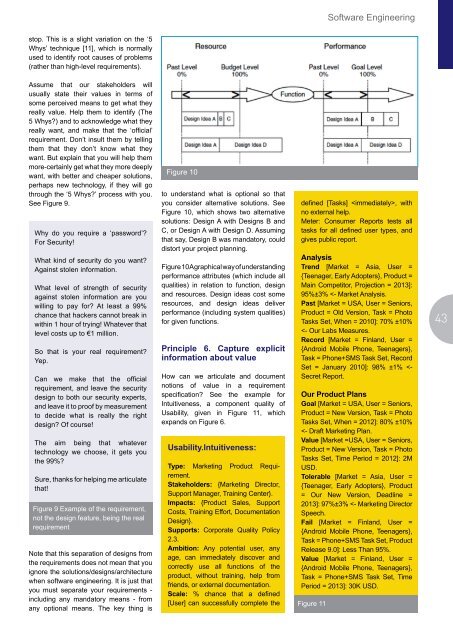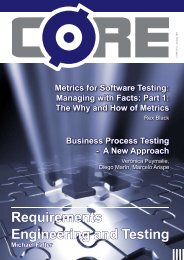Comparison of Change Management Systems
Comparison of Change Management Systems
Comparison of Change Management Systems
Create successful ePaper yourself
Turn your PDF publications into a flip-book with our unique Google optimized e-Paper software.
stop. This is a slight variation on the ‘5<br />
Whys’ technique [11], which is normally<br />
used to identify root causes <strong>of</strong> problems<br />
(rather than high-level requirements).<br />
Assume that our stakeholders will<br />
usually state their values in terms <strong>of</strong><br />
some perceived means to get what they<br />
really value. Help them to identify (The<br />
5 Whys?) and to acknowledge what they<br />
really want, and make that the ‘<strong>of</strong>ficial’<br />
requirement. Don’t insult them by telling<br />
them that they don’t know what they<br />
want. But explain that you will help them<br />
more-certainly get what they more deeply<br />
want, with better and cheaper solutions,<br />
perhaps new technology, if they will go<br />
through the ‘5 Whys?’ process with you.<br />
See Figure 9.<br />
Why do you require a ‘password’?<br />
For Security!<br />
What kind <strong>of</strong> security do you want?<br />
Against stolen information.<br />
What level <strong>of</strong> strength <strong>of</strong> security<br />
against stolen information are you<br />
willing to pay for? At least a 99%<br />
chance that hackers cannot break in<br />
within 1 hour <strong>of</strong> trying! Whatever that<br />
level costs up to €1 million.<br />
So that is your real requirement?<br />
Yep.<br />
Can we make that the <strong>of</strong>ficial<br />
requirement, and leave the security<br />
design to both our security experts,<br />
and leave it to pro<strong>of</strong> by measurement<br />
to decide what is really the right<br />
design? Of course!<br />
The aim being that whatever<br />
technology we choose, it gets you<br />
the 99%?<br />
Sure, thanks for helping me articulate<br />
that!<br />
Figure 9 Example <strong>of</strong> the requirement,<br />
not the design feature, being the real<br />
requirement<br />
Note that this separation <strong>of</strong> designs from<br />
the requirements does not mean that you<br />
ignore the solutions/designs/architecture<br />
when s<strong>of</strong>tware engineering. It is just that<br />
you must separate your requirements -<br />
including any mandatory means - from<br />
any optional means. The key thing is<br />
Figure 10<br />
to understand what is optional so that<br />
you consider alternative solutions. See<br />
Figure 10, which shows two alternative<br />
solutions: Design A with Designs B and<br />
C, or Design A with Design D. Assuming<br />
that say, Design B was mandatory, could<br />
distort your project planning.<br />
Figure 10 A graphical way <strong>of</strong> understanding<br />
performance attributes (which include all<br />
qualities) in relation to function, design<br />
and resources. Design ideas cost some<br />
resources, and design ideas deliver<br />
performance (including system qualities)<br />
for given functions.<br />
Principle 6. Capture explicit<br />
information about value<br />
How can we articulate and document<br />
notions <strong>of</strong> value in a requirement<br />
specification? See the example for<br />
Intuitiveness, a component quality <strong>of</strong><br />
Usability, given in Figure 11, which<br />
expands on Figure 6.<br />
Usability.Intuitiveness:<br />
Type: Marketing Product Requirement.<br />
Stakeholders: {Marketing Director,<br />
Support Manager, Training Center}.<br />
Impacts: {Product Sales, Support<br />
Costs, Training Effort, Documentation<br />
Design}.<br />
Supports: Corporate Quality Policy<br />
2.3.<br />
Ambition: Any potential user, any<br />
age, can immediately discover and<br />
correctly use all functions <strong>of</strong> the<br />
product, without training, help from<br />
friends, or external documentation.<br />
Scale: % chance that a defined<br />
[User] can successfully complete the<br />
S<strong>of</strong>tware Engineering<br />
defined [Tasks] , with<br />
no external help.<br />
Meter: Consumer Reports tests all<br />
tasks for all defined user types, and<br />
gives public report.<br />
Analysis<br />
Trend [Market = Asia, User =<br />
{Teenager, Early Adopters}, Product =<br />
Main Competitor, Projection = 2013]:<br />
95%±3%



